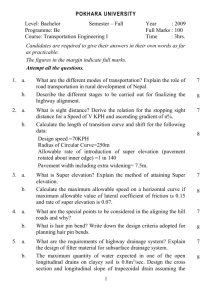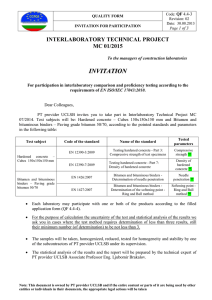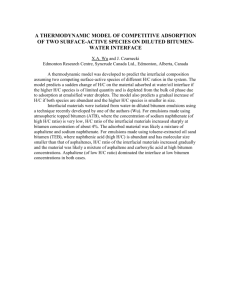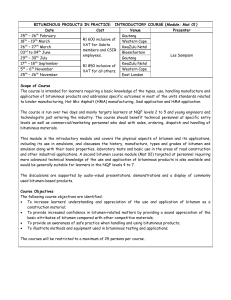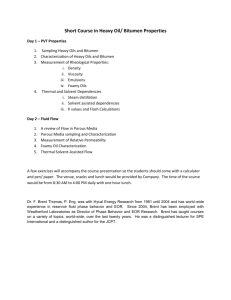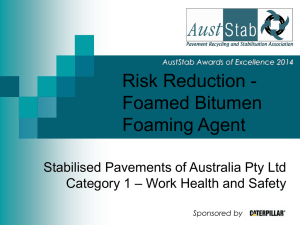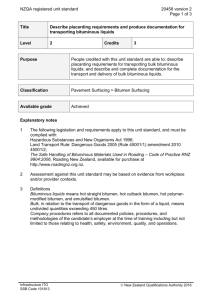S330 Sprayed Bituminous Surfacing
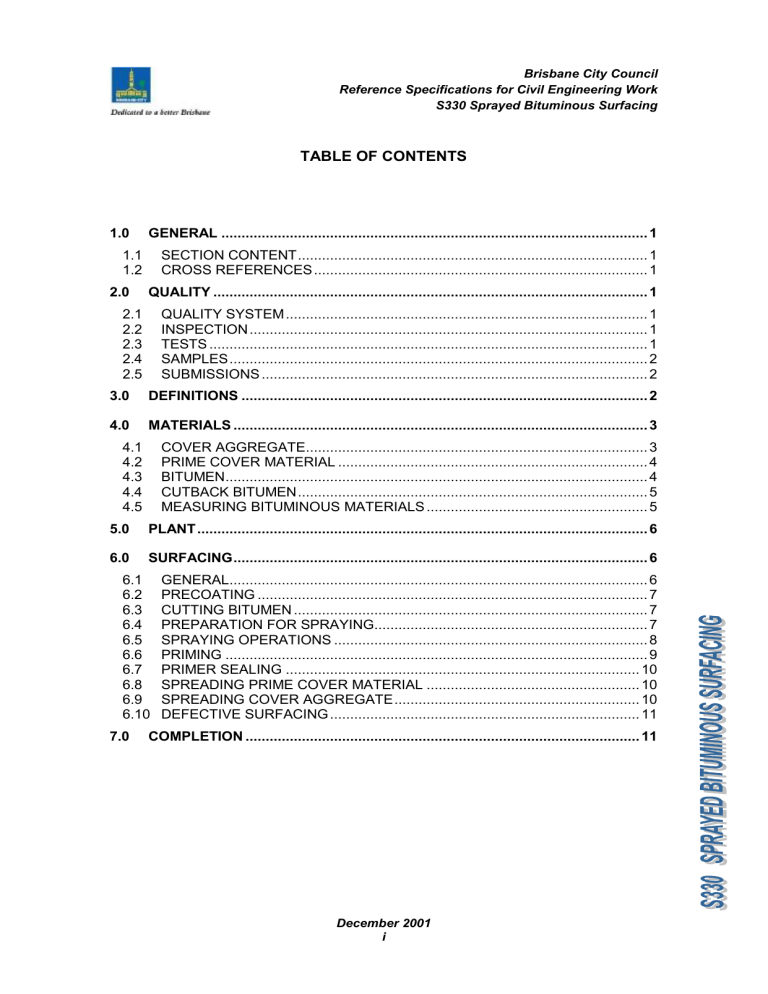
Brisbane City Council
Reference Specifications for Civil Engineering Work
S330 Sprayed Bituminous Surfacing
TABLE OF CONTENTS
1.0 GENERAL .......................................................................................................... 1
1.1 SECTION CONTENT ....................................................................................... 1
1.2 CROSS REFERENCES ................................................................................... 1
2.0 QUALITY ............................................................................................................ 1
2.1 QUALITY SYSTEM .......................................................................................... 1
2.2 INSPECTION ................................................................................................... 1
2.3 TESTS ............................................................................................................. 1
2.4 SAMPLES ........................................................................................................ 2
2.5 SUBMISSIONS ................................................................................................ 2
3.0 DEFINITIONS ..................................................................................................... 2
4.0 MATERIALS ....................................................................................................... 3
4.1 COVER AGGREGATE ..................................................................................... 3
4.2 PRIME COVER MATERIAL ............................................................................. 4
4.3 BITUMEN ......................................................................................................... 4
4.4 CUTBACK BITUMEN ....................................................................................... 5
4.5 MEASURING BITUMINOUS MATERIALS ....................................................... 5
5.0 PLANT ................................................................................................................ 6
6.0 SURFACING ....................................................................................................... 6
6.1 GENERAL ........................................................................................................ 6
6.2 PRECOATING ................................................................................................. 7
6.3 CUTTING BITUMEN ........................................................................................ 7
6.4 PREPARATION FOR SPRAYING.................................................................... 7
6.5 SPRAYING OPERATIONS .............................................................................. 8
6.6 PRIMING ......................................................................................................... 9
6.7 PRIMER SEALING ........................................................................................ 10
6.8 SPREADING PRIME COVER MATERIAL ..................................................... 10
6.9 SPREADING COVER AGGREGATE ............................................................. 10
6.10 DEFECTIVE SURFACING ............................................................................. 11
7.0 COMPLETION .................................................................................................. 11
December 2001 i
Brisbane City Council
Reference Specifications for Civil Engineering Work
S330 Sprayed Bituminous Surfacing
December 2001
Brisbane City Council
Reference Specifications for Civil Engineering Work
S330 Sprayed Bituminous Surfacing
1.0 GENERAL
1.1 SECTION CONTENT
Application of sprayed bituminous surfacing including priming, primer sealing, bitumen sealing, bitumen emulsion sealing, and resealing.
1.2 CROSS REFERENCES
Refer to the following other Reference Specifications:
S110 General Requirements: General technical requirements and interpretation of terminologies.
S120 Quality: Process control testing.
S150 Roadworks: Placing base course.
2.0 QUALITY
2.1 QUALITY SYSTEM
The supplier must maintain a Quality Assurance System with third party accreditation to
AS/NZS/ISO 9002. The supplier must notify the Contractor or Superintendent within two days of becoming aware that process control tests relevant to the work have fallen outside the specified limits.
2.2 INSPECTION
Witness points
Refer annexure . Give sufficient notice so that inspection may be made of the following stages:
Surfaces prepared for priming, sealing or surfacing.
Commencement of bituminous spraying of each seal coat.
2.3 TESTS
General
Methods: Use the specified Australian Standard or Queensland Department of Main
Roads test methods.
Testing authority: Use a testing facility registered by NATA for the test required.
Process control tests
Perform sampling and testing of the type and frequency necessary to adequately control the work. Comply with the minimum requirements specified in S120 Quality Clause 8.1
.
Refer annexure .
Compliance assessment tests
General: The Contractor or Superintendent may carry out compliance assessment testing using a testing laboratory registered with NATA for the particular test.
Records
Show records of process control tests on control charts or graphs displayed on site in a readily accessible location and updated daily.
December 2001
1
Brisbane City Council
Reference Specifications for Civil Engineering Work
S330 Sprayed Bituminous Surfacing
2.4 SAMPLES
General
On request, submit samples of each type of cover aggregate (40 kg) and bituminous material (8 L) supplied under the Contract. Refer annexure .
Identification
Attach a tag to each sample showing relevant information including description, source and nominal size of material, date sampled and by whom.
2.5 SUBMISSIONS
Test program
On request, submit details of the supplier's inspection and test program covering all specified properties of the materials. On request, submit details of recent test results demonstrating sustained compliance of the work and similar work with the required properties. Refer annexure .
Execution
General: Submit proposals for the methods and equipment to be used for the roadworks, including the following:
Staging of the work, access and traffic control methods.
Disposal of surface water, control of erosion, contamination and sedimentation of the site, surrounding areas and drainage systems.
Methods and equipment for each operation.
Sources of materials.
Material stockpiles.
Records of measurement
Submit certified records of work performed.
3.0 DEFINITIONS
Actual spray rate: The spray rate for the relevant bituminous material at 15
C achieved during the surfacing operation.
Actual spread rate: The spread rate of cover aggregate or prime cover material achieved during the surfacing operation.
Additive: Cutter oil, flux oil and/or adhesion agent.
Binder: A material (bitumen, cutback bitumen and/or polymer modified bitumen) used for the purpose of holding aggregate particles together as a coherent mixture.
Bitumen: A bituminous material obtained by processing the residue from refining certain naturally occurring crude oils.
Bitumen emulsion: A liquid product in which a substantial amount of bitumen (to which some oil may be added) is dispersed in a finely divided condition in water and stabilised, by means of one or more emulsifying agents.
Bituminous material: Bitumen, cutback bitumen, bitumen with cutter oil and/or flux oil and/or adhesion agent, polymer modified binder.
December 2001
2
Brisbane City Council
Reference Specifications for Civil Engineering Work
S330 Sprayed Bituminous Surfacing
Cover aggregate: Aggregate that forms a permanent wearing surface on a pavement.
Cutting back bitumen: The temporary reduction of bitumen viscosity by the addition of cutter oil (light petroleum distillate).
Designed spray rate: The spray rate for the relevant bituminous material at 15
C that is deemed suitable by the Superintendent.
Designed spread rate: The spread rate of cover aggregate or prime cover material that is deemed suitable by the Superintendent.
Double seal or two coat seal: A seal coat made up of two successive applications of binder and aggregate.
Flash point: The temperature at which the vapour of a substance momentarily takes fire, but does not continue to burn, when heated under specific test conditions.
Holding seal: See primer seal.
Precoating: The coating of aggregate with a precoating agent to create the initial bonding between the bituminous binder and the aggregate.
Prime: An application of a bituminous material to a prepared base as a preliminary treatment to a more permanent bituminous surfacing.
Primer: A fluid bituminous material that is applied to a prepared base.
Primer binder: A material more viscous than a primer and required to act both as a primer and binder.
Primer seal: The application of a primer binder and aggregate to a newly constructed or re-constructed prepared pavement surface, to hold that surface until a more permanent surface can be applied.
Prime cover material: Material used to cover a prime to enable traffic to use the pavement. Prime cover material may be clean sand, crusher dust or cover aggregate.
Reseal: A maintenance seal on an existing bituminous surface.
Seal: A thin surface layer of bituminous material into which aggregate has been incorporated.
Single seal: A seal coat made up of one application of binder and aggregate.
Spray run: The area of pavement selected for coverage with a bituminous material during one continuous operation with a sprayer.
4.0 MATERIALS
4.1 COVER AGGREGATE
General requirement: Cover aggregate must consist of crushed rock, crushed gravel or uncrushed gravel, and be free from dust, clay, vegetable matter and other deleterious material.
Particle size distribution (grading): Test to Queensland Department of Main Roads method Q103B or the appropriate Australian Standard method AS 1141.19 or
AS 1289.3.6.1. Comply with the requirements of Table 4.1 for the relevant nominal size.
Material properties: Test to the specified Queensland Department of Main Roads or the
Australian Standard methods. Comply with the requirements of Table 4.2 for the relevant quality category.
Conformance criteria: Comply with the requirements of S120 Quality Clause 8.2
.
December 2001
3
Brisbane City Council
Reference Specifications for Civil Engineering Work
S330 Sprayed Bituminous Surfacing
Table 4.1 - Particle size distribution
A.S. sieve size (mm) 20 mm
% passing by mass for each nominal size
16 mm 14 mm 10 mm 7 mm
26.5
19.0
16.0
13.2
9.50
6.70
4.75
2.36
100
85 - 100
0 - 20
0 - 5
0 - 1
1.18
Table 4.2 - Material properties
100
85 - 100
0 - 60
0 - 15
0 - 1
100
85 - 100
0 - 30
0 - 5
0 - 1
100
85 - 100
0 - 30
0 - 8
0 - 1
100
85 - 100
0 - 30
0 - 10
0 - 5
Property Units Test method
Aggregate quality category
A B C D
5 mm
100
85 - 100
0 - 30
0 - 5
Flakiness index (nominal sizes
10 mm)
% max Q201B or AS 1141.15 30 35 35 35
Ten percent fines values (wet) # kN min Q205B or AS 1141.22 175 150 100 100
Wet/dry strength variation # * % max Q205C or AS 1141.22 30 35 40 40
Proportion of weak particles % max Q217 or AS 1141.32 1 2 3 3
Crushed particles % min Q215 or AS 1141.18 80 80 80 N/A
# Carry out test on one significant sieve fraction, where possible, on particles passing the A.S.
13.2 mm sieve but retained on the A.S. 9.5 mm sieve.
* If Greenstone source material (Metamorphic Group) does not comply with the specified maximum wet/dry strength variation limits, it may be used provided that the ten percent fines values (wet) is at least 60 kN greater than the specified maximum value for the relevant subtype.
4.2 PRIME COVER MATERIAL
General requirement: Prime cover material must consist of natural sand or crushed rock particles of size generally smaller than 4.75 mm but larger than 0.075 mm.
Contamination: Prime cover material must be free from soluble salts, organic matter, clay and other deleterious material.
4.3 BITUMEN
Bitumen: Generally to AS 2008.
Bitumen emulsion: To AS 1160.
General requirement: Bitumen must be homogeneous and free from any inorganic matters, other than that naturally present in crude petroleum.
Foaming: Bitumen must not foam when heated to 175
C.
Material properties: Comply with the requirements of Table 4.3.
Conformance criteria: Comply with the requirements of S120 Quality Clause 8.2
.
December 2001
4
Brisbane City Council
Reference Specifications for Civil Engineering Work
S330 Sprayed Bituminous Surfacing
Table 4.3 - Material properties
Property Unit
Test method
QDMR Australian
Standard
Viscosity at
60
C
Pa.s
Viscosity at
135
C
Pa/s
Density at 15
C t/m 3
Flashpoint
C pu Penetration at
25
C
RTFO viscosity ratio
Solubility
%
Matter insoluble in toluene
% by mass
% by mass
TBR = to be recorded
Q330/ Q340
Q330/ Q340
Q331
Q333
Q335
Q338
Q332
AS 2341.2
AS 2341.2
Class 170
Min Max
140
Class 320
Min Max
260 380
0.25 0.45 0.40 0.65
AS 2341.7 TBR
AS 2341.14 250
AS 2341.12 62
AS 2341.2
AS 2341.8
-
99.0
-
200
-
-
-
300
-
1.0
TBR
250
40
-
99.0
-
-
-
-
300
-
1.0
4.4 CUTBACK BITUMEN
Cutback bitumen: Generally to AS 2157. A product made from residual bitumen complying with AS 2008 by the addition of cutter oil complying with AS 3568. Select grades to suit the prepared surface and the weather conditions.
Priming classes: Cutback bitumen grades AMC00, AMC0, AMC1.
Primer sealing and premix classes: Cutback bitumen grades AMC2, AMC3, AMC4.
Sealing classes: Cutback bitumen grades AMC5, AMC6, AMC7.
Mixture: Use volatile diluent compatible with the bitumen to produce a homogeneous mixture.
Storage and transport: Store and transport in purpose built containers in such a way that contamination does not occur.
Flashpoint: Test to AS 2341.16 or Main Roads method Q371. A minimum flashpoint temperature of 38
C applies to cutback bitumen grades AMC00, AMC0, AMC1, AMC2,
AMC3 and AMC4. A minimum flashpoint temperature of 50
C applies to cutback bitumen grades AMC5, AMC6 and AMC7.
Other material properties: Comply with the requirements of AS 2157.
Conformance criteria: Comply with the requirements of S120 Quality Clause 8.2
.
4.5 MEASURING BITUMINOUS MATERIALS
General: Measure by volume at 15
C.
Temperatures higher than 15
C: Use the bitumen volume conversion formula for primers and binders, where T is the temperature of the material at which the volume has been measured. For calculation purposes, assume that the conversion factors are the same for bitumen, bituminous mixes and cutter.
Bitumen volume conversion formula: Volume at T
C = Volume at 15
C / [1-(T-15)/1667]
December 2001
5
Brisbane City Council
Reference Specifications for Civil Engineering Work
S330 Sprayed Bituminous Surfacing
5.0 PLANT
General: Provide the required plant necessary for the performance of the particular operation.
Aggregate spreader: A mechanical spreader capable of accurately spreading a uniform layer of aggregate.
Bitumen tank: A tank suitable for the storage and/or transport of bitumen.
Drag broom: A mechanical broom suitable for the distribution of unevenly spread aggregate without disturbance of particles freshly embedded in binder.
Road broom: A drawn rotary broom or self propelled rotary broom suitable for sweeping or cleaning road surfaces. Where suitable, a vacuum system may be used.
Rubber-tyred roller: A dual axle, multi-wheeled roller with a minimum load of one tonne per tyre. Tyres must be smooth and be able to operate at a pressure of at least
550 kPa.
Sprayer: A bitumen sprayer that complies with the requirements of Austroads publication Bitumen Sprayers , and has a current Sprayer Certificate issued by
Queensland Department of Main Roads or by an approved national testing authority.
Steel-wheeled roller: A roller with steel wheels having a minimum diameter of 0.9 m and a maximum axle load of 5 tonnes. Do not use vibratory equipment unless approved otherwise by the Superintendent.
6.0 SURFACING
6.1 GENERAL
Finished surface level tolerances
General: Provide a finished surface that is free draining and evenly graded between level points.
Edges abutting gutters: Within + 5 mm or flush with the level of the actual gutter edge or lip of channel.
Horizontal surfaces
Absolute tolerance:
50 mm, except where alignment with an existing road structure is necessary. Join new construction to the existing work in a smooth manner.
Surfacing system
Specify details of the surfacing treatment in the annexure. Refer annexure .
December 2001
6
Brisbane City Council
Reference Specifications for Civil Engineering Work
S330 Sprayed Bituminous Surfacing
6.2 PRECOATING
Precoating agents
Provide precoating agents that have satisfied plate stripping tests with the binder and aggregate. The percentage of stripping determined in accordance with the Australian
Standard test method AS 1141.50 must not exceed 10%.
Application
General: Apply precoating agent thinly and evenly using a fine pressure spray to a moving stream of aggregate, or by other suitable means, so that particles are fully coated without excess material.
Degree of precoat: At least 85% of the total surface area of the aggregate is covered with the precoating agent in accordance with Queensland Department of Main Roads test method Q216.
Wet aggregate: If the aggregate is too wet to precoat, or contains enough moisture to cause uneven distribution of the precoating agent, dry the aggregate by turning the stockpile over. Do not provide precoated aggregate containing moisture until the moisture has evaporated and the precoating agent has adhered efficiently.
Application rate: Generally 6 - 12 L/m 3 of aggregate. Vary rate of precoating agent to suit the nature of the aggregate, the efficiency of the precoating methods, the absorptive properties of the aggregates, and the amount of moisture and dust present.
Lead times: Apply oil based precoating agent immediately before the aggregate is loaded into the spreader trucks. Apply tar precoating agent at least 1 week before use to allow the tar to dry on the aggregate.
6.3 CUTTING BITUMEN
Generally: Heat sufficient bitumen for immediate needs only. Do not keep the material at spraying temperature for longer than 10 hours. Do not reheat.
Mixing and heating (on site): Heat the bitumen at a rate not exceeding 30
C/h and circulate cutback bitumen for 20 minutes to ensure through mixing.
Heating devices: Use devices capable of uniform heating without damaging bituminous materials.
6.4 PREPARATION FOR SPRAYING
Surface preparation
Extent: Prepare surface to be sprayed plus either an area that is a minimum of 250 mm beyond the surface to be sprayed, or one which extends to the edge of the formation, whichever is the lesser.
Cleaning
General: Immediately before spraying remove loose and foreign material on the finished base surface, including dust, debris and sand spread on primed surfaces, and until a mosaic of well embedded stone shows on the surface. Keep traffic off the cleaned surface.
Method: Use suitable power blowers or road brooms, or using hand methods where inaccessible to power equipment.
December 2001
7
Brisbane City Council
Reference Specifications for Civil Engineering Work
S330 Sprayed Bituminous Surfacing
Potholes
Trim to a regular shape and a uniform depth of at least 75 mm. Tack coat the sides and bottom, and patch with a suitable bituminous premix, sanded after completion. Allow sufficient time for premix to cure before spraying the surface.
6.5 SPRAYING OPERATIONS
Protection
Protect adjacent surfaces during spraying. Place drip trays under spray bars when the sprayer is stationary. Clean bituminous materials from adjacent surfaces or, if this is not possible, replace and make good the surface. Protect freshly sprayed surfaces from contamination.
Restrictions
Pavement surface temperature: Do not commence spraying until the surface temperature of the pavement is above 20
C for bitumen or above 25
C for polymer modified binder, for at least one hour before spraying commences. Refer annexure .
Weather conditions: Do not spray during rain or if rain is likely to fall prior to the spreading of cover aggregate and the completion of rolling.
Minimum period between bituminous treatments: Allow at least 3 days between priming and sealing and between first and second seals. Allow at least 14 days between a primer seal and a seal. Refer annexure .
Method of application
Apply bituminous materials by means of the mechanically operated spray bar of a bitumen sprayer. In areas not accessible to the mechanical sprayer, spray using hand spray equipment attached to the mechanical sprayer.
Spraying
General: Completely and uniformly cover the surface to be treated. Prevent the spray overlapping previously treated areas, except that where part width spraying is used, lap the longitudinal joint between adjacent runs by 50 mm.
Table 6.2 - Primer application rates
Surface type Suitable primer grade
Application rate
Low porosity. Extremely hard and tightly bonded surface such as dense graded crushed rock.
AMC00 or AMC0 (low viscosity primers)
Medium porosity. Gravels with sandy silt binders. AMC0 or AMC1 (medium viscosity primers)
High porosity. Lack of textured appearance resulting from deficient binding material.
AMC1 or AMC2 (high viscosity primers)
0.5 - 1.0 L/m 2
0.5 - 1.0 L/m 2
0.8 - 1.4 L/m 2
December 2001
8
Brisbane City Council
Reference Specifications for Civil Engineering Work
S330 Sprayed Bituminous Surfacing
Spraying temperature
Spray bituminous material within the temperature range given in Table 6.3.
Table 6.3 - Spraying temperature range of bituminous material
Material Grade
Spraying temperature range (
C)
Minimum Maximum
Cutback bitumen AMC00
AMC0
AMC1
AMC2
AMC3
AMC4
AMC5
AMC6
AMC7
Ambient
35
60
75
95
110
120
135
150
Ambient
55
80
100
115
135
150
160
175
Bitumen Class 170
Class 320
160
170
190
195
Modified bitumen *
* Refer to manufacturer’s recommendations
Recording
* *
Requirement: After each spray run, record all details of the sealing operations on appropriate bituminous materials spraying record sheets.
Actual spray rate: Calculate actual spray rate for each spray run at 15
C prior to the next spray run. Use volume conversion formula specified in Clause 4.5
in relation to changes in temperature of bituminous materials.
6.6 PRIMING
General: Prime the newly constructed granular pavement to achieve and maintain a strong bond between the granular surface and the permanent treatment seal.
Material: Cutback bitumen grades complying with AS 2157.
Application: Select cutback bitumen grades and application rates to suit the pavement surface, generally in accordance with Table 6.2.
Pavement dry back: Do not prime on damp pavement. Allow the top pavement surface to dry out sufficiently to achieve 6 - 10 mm depth of primer penetration into the pavement pores.
Primed surface: Keep traffic off the primed surface. Where the primed surface is open to light traffic use (such as pedestrian and light construction traffic), cover surface with clean sand or crusher dust. Allow at least 4 hours between priming and the spreading of prime cover material.
Unkerbed edges: Extend the primer 150 mm beyond the edge of the seal.
December 2001
9
Brisbane City Council
Reference Specifications for Civil Engineering Work
S330 Sprayed Bituminous Surfacing
6.7 PRIMER SEALING
General: Provide primer seal to newly constructed granular pavement that is subject to vehicular traffic or to cold planed (profiled) surface where the granular pavement is exposed or to hold the newly constructed pavement in good condition until the permanent seal treatment can be applied.
Moisture content: Do not primer seal pavement that have a high moisture content at optimum or above. Allow the pavement to dry back to at least 0.5% (preferably 1%) below the optimum moisture content before applying the primer seal.
6.8 SPREADING PRIME COVER MATERIAL
Spreading: Spread prime cover material evenly to completely cover the surface.
Wet cover material: Do not use wet cover material containing free surface water.
Time limit: Allow at least 4 hours between priming and the application of cover material to permit penetration of the prime, unless traffic requirements dictate otherwise.
Excess cover material: Remove all excess cover material from the pavement.
6.9 SPREADING COVER AGGREGATE
Spreading
Timing: Immediately after the binder or primer binder has been sprayed, cover with a uniform layer of precoated aggregate. Do not leave any portion of binder without cover aggregate for longer than 10 minutes after spraying.
Method: Carry out spreading using an aggregate spreader. Spread cover aggregate to form a single layer on the pavement surface of partly interlocked aggregates after compaction. Make every attempt to achieve the required spread pattern on the first spreading pass.
Under spreading: Retreat bare or insufficiently covered areas as soon as possible with a further light spreading run or by hand spreading.
Uneven distribution: Drag broom the affected area until it is evenly distributed without dislodgment of any embedded cover aggregate.
Sealing: Incorporate the first course of aggregate thoroughly into the binder before a second course is applied. Remove loose particles from the sealed area by sweeping lightly, without disturbing embedded aggregate.
Pneumatic tyred rolling
Timing: Immediately after spreading, roll and drag broom the area until it is uniformly covered with aggregate thoroughly embedded in the binder. Roll uniformly over the whole area with multi-tyred rollers. Complete rolling as soon as possible but not later than 3 days after spraying. Roll during daylight hours.
Rolling rate: Not less than 6 passes within 1 hour of spraying at every point on the surface. Refer annexure .
Moist cover aggregate: For Class 170 bitumen, delay rolling until the cover aggregate has dried sufficiently to promote adhesion but not such that the binder has become cold.
For polymer modified binder, start rolling immediately and continue until adhesion is complete.
December 2001
10
Brisbane City Council
Reference Specifications for Civil Engineering Work
S330 Sprayed Bituminous Surfacing
Loose aggregate
When the aggregate has been evenly spread and embedded, remove loose particles remaining on the pavement and apply additional aggregate as required.
Surface finish
Provide an even, smooth riding and free draining surface.
6.10 DEFECTIVE SURFACING
Primer
Actual rate of application < 90% of designed spray rate: Make up the deficiency with a second spray run.
Actual rate of application > 110% of designed spray rate: Cover the surface with sand.
Binder and primer binder
Actual rate of application < 90% or > 110% of designed spray rate: Remove defective seal and reseal the surface.
Conformance criteria
Acceptance and rejection criteria: Comply with the requirements of S120 Quality
Clause 8.2
.
7.0 COMPLETION
Traffic on pavement
Give notice before opening the pavement to traffic before the work is completed.
Provide adequate means of protection.
December 2001
11
Brisbane City Council
Reference Specifications for Civil Engineering Work
S330 Sprayed Bituminous Surfacing
December 2001
